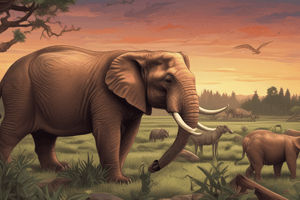Podcast
Questions and Answers
How does ocean acidification, a consequence of increased CO2 absorption, primarily threaten endangered marine species?
How does ocean acidification, a consequence of increased CO2 absorption, primarily threaten endangered marine species?
- By increasing the buoyancy of marine animals, making them more susceptible to predation.
- By creating underwater dead zones devoid of oxygen, suffocating marine life.
- By harming shellfish and coral reefs, which are vital habitats and food sources. (correct)
- By directly poisoning marine animals through carbonic acid production.
Which of the following is a significant challenge in protecting endangered species, particularly when considering the needs of local communities?
Which of the following is a significant challenge in protecting endangered species, particularly when considering the needs of local communities?
- Enforcing strict regulations that disregard local economic dependencies on natural resources.
- Prioritizing the introduction of invasive species to supplement the food supply for endangered animals.
- Balancing conservation goals with the socio-economic needs and cultural practices of local communities. (correct)
- Relocating entire human populations to create larger protected areas for wildlife.
How can DNA sequencing and genetic analysis aid in the conservation of endangered populations?
How can DNA sequencing and genetic analysis aid in the conservation of endangered populations?
- By predicting future climate patterns with greater accuracy.
- By cloning extinct species to reintroduce them into their former habitats.
- By identifying and managing endangered populations, understanding genetic diversity, and preventing inbreeding. (correct)
- By creating genetically modified organisms resistant to climate change.
What is a key role of citizen science in protecting endangered species?
What is a key role of citizen science in protecting endangered species?
Which of the following adaptation strategies is LEAST likely to be effective for endangered animals facing climate change?
Which of the following adaptation strategies is LEAST likely to be effective for endangered animals facing climate change?
What is a primary function of the International Union for Conservation of Nature (IUCN) in the context of endangered species?
What is a primary function of the International Union for Conservation of Nature (IUCN) in the context of endangered species?
Which of the following is the most effective mitigation strategy for the long-term protection of endangered species from climate change?
Which of the following is the most effective mitigation strategy for the long-term protection of endangered species from climate change?
What ethical consideration is most pertinent when discussing endangered species protection?
What ethical consideration is most pertinent when discussing endangered species protection?
How does habitat fragmentation, exacerbated by climate change, specifically impact endangered migratory birds?
How does habitat fragmentation, exacerbated by climate change, specifically impact endangered migratory birds?
What role do protected areas and wildlife corridors play in the conservation of endangered species?
What role do protected areas and wildlife corridors play in the conservation of endangered species?
Flashcards
Endangered Animals
Endangered Animals
Species at risk of extinction due to habitat loss, poaching, and climate change.
Climate Change: Rising Temperatures
Climate Change: Rising Temperatures
Rising temperatures cause habitat shifts, forcing animals to migrate or face extinction.
Ocean Acidification
Ocean Acidification
Increased CO2 absorption harms marine life, especially shellfish and coral reefs.
Polar Bears and Climate Change
Polar Bears and Climate Change
Signup and view all the flashcards
Coral Reefs and Bleaching
Coral Reefs and Bleaching
Signup and view all the flashcards
Habitat Preservation
Habitat Preservation
Signup and view all the flashcards
CITES
CITES
Signup and view all the flashcards
Remote Sensing
Remote Sensing
Signup and view all the flashcards
Biodiversity
Biodiversity
Signup and view all the flashcards
Renewable Energy
Renewable Energy
Signup and view all the flashcards
Study Notes
- Endangered animals are species at risk of extinction due to habitat loss, poaching, and climate change.
- Climate change intensifies the threats to endangered animals, disrupting ecosystems and altering habitats.
Impact of Climate Change on Endangered Animals
- Rising temperatures force animals to migrate or face extinction due to habitat shifts.
- Changes in precipitation patterns cause droughts or floods, impacting food and water availability.
- Ocean acidification, from increased CO2 absorption, harms marine life, especially shellfish and coral reefs.
- Extreme weather events like hurricanes and wildfires destroy habitats and reduce populations.
- Altered breeding cycles and mismatches in seasonal events disrupt reproduction and survival rates.
Specific Examples of Endangered Animals Affected by Climate Change
- Polar bears' hunting of seals is threatened by melting sea ice, reducing their food supply.
- Coral reefs, habitats for marine species, suffer bleaching from warmer ocean temperatures.
- Amphibians, such as frogs, are susceptible to temperature and moisture changes, leading to declines.
- Migratory birds face challenges from altered migration routes and food scarcity along their journeys.
- Mountain gorillas in Africa are threatened by habitat loss and diseases, exacerbated by climate changes.
Conservation Strategies to Protect Endangered Animals
- Habitat preservation and restoration provide safe environments for endangered species.
- Reducing greenhouse gas emissions is crucial to mitigate climate change impacts.
- Anti-poaching measures protect animals from illegal hunting.
- Protected areas and wildlife corridors facilitate movement and genetic exchange.
- Research and monitoring help understand climate change effects on animal populations.
- Sustainable practices in agriculture, forestry, and fisheries reduce habitat destruction.
- Raising public awareness and engaging local communities in conservation efforts is important.
The Role of International Organizations
- The International Union for Conservation of Nature (IUCN) assesses the conservation status of species.
- The Convention on International Trade in Endangered Species (CITES) regulates trade in endangered animals and plants.
- The United Nations Framework Convention on Climate Change (UNFCCC) aims to reduce greenhouse gas emissions.
- Conservation organizations protect endangered species through research, advocacy, and on-the-ground projects.
Challenges in Protecting Endangered Animals
- Limited funding and resources hinder conservation efforts.
- Political instability and conflicts disrupt conservation activities.
- Lack of public awareness and support impedes conservation efforts.
- Climate change impacts are complex and make planning challenging.
- Balancing conservation goals with local community needs can be difficult.
Technological Solutions for Conservation
- Remote sensing and satellite imagery monitor habitat changes and animal movements.
- DNA sequencing and genetic analysis help identify and manage endangered populations.
- GPS tracking devices monitor animal behavior and migration patterns.
- Drones survey wildlife populations and detect poaching activities.
- Camera traps capture images of animals in remote areas, providing valuable data.
The Importance of Biodiversity
- Endangered animals are integral to biodiversity, supporting ecosystem functions.
- Loss of species can have cascading effects on ecosystems, leading to imbalances.
- Biodiversity provides pollination, water purification, and climate regulation.
- Conserving endangered animals maintains the integrity and resilience of ecosystems.
Climate Change Mitigation Strategies
- Transitioning to renewable energy sources reduces greenhouse gas emissions.
- Improving energy efficiency in buildings, transportation, and industry lowers energy consumption.
- Implementing carbon capture and storage technologies removes CO2.
- Promoting sustainable land use like reforestation increases carbon sequestration.
- Reducing deforestation protects carbon sinks and preserves biodiversity.
Adaptation Strategies for Endangered Animals
- Assisting animals in migrating to more suitable habitats is important.
- Creating artificial or modifying existing habitats accommodates changing conditions.
- Providing supplemental food and water helps animals during times of scarcity.
- Captive breeding programs increase population numbers.
- Vaccinating animals protects against diseases that may become more prevalent.
The Economic Impact of Endangered Species Loss
- Loss of tourism revenue is associated with reduced wildlife viewing.
- Reduced productivity of ecosystems affects agriculture and fisheries.
- Increased costs are associated with managing invasive species.
- There is a loss of potential medicinal compounds and other valuable resources.
- Ecosystem services are impacted, such as pollination, water purification, and climate regulation.
The Ethical Considerations of Endangered Species Protection
- There is the intrinsic value of all living organisms to consider.
- There is a moral responsibility to protect endangered species from extinction.
- A need to balance human needs with the needs of other species exists.
- Intergenerational equity is important in ensuring future generations benefit from biodiversity.
The Role of Citizen Science
- Citizen scientists collect data on animal populations and habitats.
- They monitor environmental conditions, such as temperature and water quality.
- They participate in habitat restoration projects.
- They can educate others about endangered species and conservation issues.
- Citizen science projects increase public awareness and engagement.
The Impact of Pollution on Endangered Animals
- Chemical pollutants contaminate food and water sources, harming animals.
- Plastic pollution entangles animals or is ingested, leading to injury or death.
- Noise pollution disrupts animal communication and behavior.
- Light pollution interferes with animal navigation and reproduction.
- Air pollution can damage animal respiratory systems.
Case Study: The California Condor
- The California Condor faced near extinction due to lead poisoning and habitat loss.
- A captive breeding program was initiated to increase the population size.
- Lead ammunition was phased out to reduce lead exposure.
- The Condor population has slowly recovered, but faces ongoing challenges.
The Social Dimensions of Conservation
- Engaging local communities in conservation planning and implementation helps.
- Respecting the rights and traditional knowledge of indigenous peoples is crucial.
- Addressing social and economic inequalities that contribute to habitat destruction must be a priority.
- Promoting sustainable livelihoods that benefit people and wildlife is important.
- Fostering a sense of stewardship and responsibility for the environment will ensure long-term protection.
The Future of Endangered Species
- Continued efforts to reduce greenhouse gas emissions are essential to survival.
- Increased investment in conservation research and management is needed.
- Greater collaboration among governments, organizations, and individuals is required.
- A shift towards sustainable lifestyles and consumption patterns is necessary.
- Education and awareness programs can inspire people to take action.
Studying That Suits You
Use AI to generate personalized quizzes and flashcards to suit your learning preferences.




